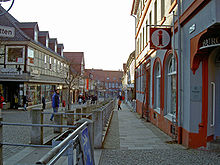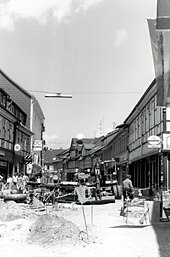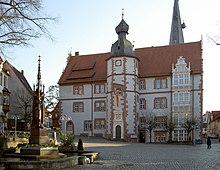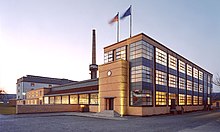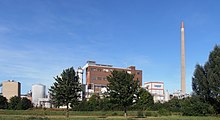Alfeld (leash)
| coat of arms | Germany map | |
|---|---|---|

|
Coordinates: 51 ° 59 ′ N , 9 ° 49 ′ E |
|
| Basic data | ||
| State : | Lower Saxony | |
| County : | Hildesheim | |
| Height : | 119 m above sea level NHN | |
| Area : | 72.87 km 2 | |
| Residents: | 18,535 (Dec. 31, 2019) | |
| Population density : | 254 inhabitants per km 2 | |
| Postal code : | 31061 | |
| Area code : | 05181 | |
| License plate : | HI, ALF | |
| Community key : | 03 2 54 002 | |
| City structure: | 17 districts | |
City administration address : |
Marktplatz 1 31061 Alfeld (Leine) |
|
| Website : | ||
| Mayor : | Bernd Beushausen ( SPD ) | |
| Location of the city of Alfeld (Leine) in the Hildesheim district | ||
Alfeld (Leine) is a small town and an independent municipality in the Hildesheim district in southern Lower Saxony . Alfeld is the second largest city in this district and is located in the middle of the Hanover-Braunschweig-Göttingen metropolitan region .
geography
location
Alfeld is located in the Leinebergland between the Leine in the west and the Seven Mountains (up to 395 m high) in the northeast. The surrounding mountains are called Alfelder Bergland or Ith - Hils -Bergland (up to 480.4 m high).
Urban structure (districts)
|
Neighboring communities
|
Duingen ( Leinebergland municipality ) |
Gronau (Leinebergland municipality) |
Sibbesse |

|
||
|
Delligsen ( district of Holzminden ) |
Freden |
history
Although this has not yet been documented, it can be assumed that Alfeld, as a city, was founded parallel to the Hildesheim dam city . This is indicated by the planned layout of the city center within the ramparts, the parallel existence of a Nikolaikirche and the documentary mention of Flemish settlers in both settlements for the beginning of the thirteenth century. The coats of arms are also almost identical. Alfeld's coat of arms differs from that of the dam city only in the blue shield hump, which is traditionally identified as the blue stone .
Alfeld could have been granted city rights between the year 1220 (in which Emperor Friedrich II guaranteed sovereign rights to the clerical princes in the Confoederatio ) and the year 1258 (the year of the oldest documented mention of Alfeld as a city). In 1315 the city of Dassel was granted Alfeld town charter.
The city was one of the smallest cities in the Hanseatic League . Alfeld joined the Saxon City Association in 1426 . The city, which grew rich in the 14th and 15th centuries through the trade in beer , hops, linen and linen yarn, indirectly became a Hanseatic city .
In the oldest time Alfeld belonged to the diocese of Hildesheim . After the Hildesheim collegiate feud (1519–1523) it came to the Principality of Braunschweig-Wolfenbüttel . In retrospect, the Braunschweig period was Alfeld's golden age, in which Alfeld's economy and culture flourished.

Notgeld from 1921, designed by Käte Reiche
During the Thirty Years' War , Tilly and Wallenstein , both well-known generals of the Catholic League , met on October 13, 1625 in the Alfeld district of Limmer for a conversation. 1643 fell Alfeld after the separate peace from Goslar to the Bishopric of Hildesheim back. As a result of the Reichsdeputationshauptschluss , it briefly came to Prussia in 1803 , then to the Kingdom of Westphalia, Hildesheim district , after the Congress of Vienna in 1815 it was subordinated to the Kingdom of Hanover . As a result of the German War , it was annexed by Prussia in 1866, to which Alfeld also belonged until the end of the Second World War , which was displeasing to the welf-loyal sections of the population. Alfeld has belonged to the state of Lower Saxony since 1946 . Alfeld was not destroyed during the Second World War. This is one of the reasons why the Alfeld University of Education was founded here in 1946 , which was relocated to Hildesheim in 1969/70.
The place name
Former place names of Alfeld were in the years 1214 Alvelde, 1221 Alvelde and 1233 Alvelde. The place name component "-feld" means "free area", "the free, open field", "undeveloped field". “Al-” is most closely related to the Indo-European roots “el-”, “ol-” and means “water”, “moist”, “flowing”.
Incorporations
On March 1, 1974 the communities Brunkensen (until then in the district of Holzminden ), Dehnsen, Eimsen, Föhrste, Gerzen, Hörsum, Imsen, Langenholzen, Limmer, Lütgenholzen (until then in the district of Holzminden), Röllinghausen, Sack, Warzen, Wettensen and Wispenstein incorporated.
religion
The St. Nicolai Church , the Friedenskirche in the west of the city and the churches in the Alfeld districts belong to the Hildesheimer Land-Alfeld parish of the Evangelical Lutheran regional church of Hanover.
The Catholic parish of St. Marien belongs to the Deanery Alfeld-Detfurth of the Diocese of Hildesheim. In addition to the St. Marien Church in Alfeld, it has also included the Catholic churches in Delligsen , Duingen , Everode and Winzenburg since 2006 .
Other religious communities in Alfeld are the Ecclesia , the New Apostolic Congregation and the Jehovah's Witnesses .
politics
City council
The Alfeld City Council currently consists of 32 members. This is the specified number for a municipality with a population between 15,001 and 20,000. The council is elected for a five-year term in local elections. The current term of office began on November 1, 2016 and ends on October 31, 2021.
The last local elections resulted in the following distribution of seats immediately after the election (the votes received in brackets) :
| Local election | SPD | CDU | BAL | Green | FDP | total |
|---|---|---|---|---|---|---|
| 11th September 2016 | 15 (12,698) |
10 (8,995) |
4 (3,136) |
2 (1,955) |
1 (785) |
32 seats |
| September 11, 2011 | 16 (12,740) |
10 (7,767) |
5 (3,641) |
3 (2,180) |
- | 34 seats |
| September 10, 2006 | 19 (15,353) |
10 (8,231) |
3 (2,518) |
1 (952) |
1 (917) |
34 seats |
mayor
The mayor of the city of Alfeld (Leine) is Bernd Beushausen (SPD). He was first elected on September 10, 2006. On September 11, 2016, he was re-elected with 58.9% and was able to prevail against the CDU candidate Andreas Behrens (41.1%).
His deputy is Andrea Brodtmann (SPD).
coat of arms
The city was awarded the municipal coat of arms on May 3, 1939 by the President of the Province of Hanover . The district administrator from Alfeld presented it on December 19 of the same year.
| Blazon : “In red a silver city gate with two square tin towers on the right and left and a Gothic stepped gable in the middle. In the pointed archedgatearea a golden portcullis, in front of ita semicircular heraldic shield , squared of gold and red, leaning diagonally to the right , with a blue , hunched disc in the middle. " | |
| Justification of the coat of arms: The redesign of the Alfeld coat of arms is based on the representation of an Alfeld city gate in the Sassenchronik from 1492. But instead of the round towers there, two square tin towers are designed based on the model of the so-called filler tower that is still preserved. The old city coat of arms placed in the gate entrance is first attested with its colors in 1437, but without the blue, hunched disk in it, which is first depicted in the Sassenchronik in 1492. |
Flag and colors of the city
- The flag has gold and red stripes and is covered with the city's coat of arms.
- The colors are the Hildesheim colors: gold-red.
Town twinning
- Since December 15, 1991 Alfeld has been a twin town of the English city of Wakefield .
- A very long partnership exists with the English city of Sidmouth . Students from the Carl-Benscheidt-Realschule visit this place every year as part of the school exchange.
- The high school has a partnership with a school in the French city of Nîmes .
Culture and sights
Buildings

The image of Alfeld's old town is shaped by half-timbered buildings , which, after the devastating city fires of the past, mostly come from the 19th century. Due to the interesting half-timbered houses, Alfeld is a stop on the German half-timbered road .
An impressive building of the Renaissance among the half-timbered buildings is the Latin school from 1610. It is adorned with numerous carved panels, the pictorial program of which provides a comprehensive picture of the educational content of late humanism . Numerous symbolic references in the representations refer to the pansophic time background of the early 17th century, i.e. the time of Jakob Böhme or Johann Valentin Andreae , such as the representation of the chymic wedding and the Jacob's ladder . Among other things, the allegories for the seven liberal arts with the symbols grammar (rod), dialectic (snake or dog's head), rhetoric (blackboard and stylus ), music (musical instrument), arithmetic ( abacus or ruler ), geometry ( compass or dust table) and astronomy ( astrolabe ). The Latin school now houses the Alfeld City Museum. The associated animal museum is housed in the neighboring building. Below the animal museum, on the south side of the churchyard, is the historic Ratsbadstube, the oldest documentary evidence of which dates from 1501. The buildings of the Ratsbadstube include a vaulted cellar made of sandstone (a barrel vault with 110 m² base and 3.50 m crown height) and three half-timbered houses built on top of it.
The so-called Alfeld Planetary House , which was probably built in 1608 according to an inscription earlier on the building, is remarkable . It has two rows of carved panels showing representations of the seven planets and the five senses. The juxtaposition of planets or metals and the human body is to be read against the time background as a representation of the correspondence of microcosm and macrocosm according to Paracelsus . On the planet house there is also a carved frieze depicting the unicorn and two mythical creatures, presumably this is a pharmacy symbolism . The documentary evidence of a pharmacy in the planet house has not yet succeeded - despite references to the existence of a unicorn pharmacy in Alfeld in the 17th century. Other buildings decorated with carved panels in Alfeld were the caland house from the late 16th century, which burned down at the beginning of the 20th century (individual panels have been preserved and are kept in the Latin school used as a local museum) and another building on the market square, but its carved panels are already there were removed towards the end of the 19th century.
Noteworthy among the older buildings is the renovated town hall, which in its current appearance (since 1586) is a building of the so-called Weser Renaissance . Traces of earlier Gothic construction stages can still be seen, such as a (over-molded) Gothic stepped gable in the west. The town hall is maintained by the Waltraud and Burghard Meyer Foundation (both founders are from Alfeld).
The Gothic hall church St. Nicolai is worth seeing , which was already an archdeaconate church in 1205 and today (since 1542 Protestant) is Alfeld's town church and is the house church of the Alfeld superintendent. Ms. Katharina Henking has been the superintendent since 1st Advent 2011, the first female superintendent in 470 years. The Reformation was introduced by Bugenhagen in Alfeld.
The main altar of the St. Nicolai Church, which was originally dedicated to the city's patron saint, St. Nicholas, and the Holy Virgin Mary, is now in the Minoritenkirche (Cologne) , where a former superintendent is said to have sold it without authorization. The fate of the altar and its seller is exemplary, especially for the way the Alfeld Church handled the art-historical treasures entrusted to it, to which numerous altars and epitaphs fell victim. Of the remains of the originally rich interior of the St. Nicolai Church, an early Gothic triumphal cross from the first third of the 13th century should be emphasized, perhaps the only work of art of world art in Alfeld.
In the 13th century Alfeld received a city fortification, initially consisting of a city wall with four city gates. These were called Perkdor (Sedanstraße), Holzerdor (Holzer Straße), Hörserdor (Seminarstraße) and Leyndor (Leinstraße). Later a wall was placed in front of the wall. One of the city towers is the Fillerturm, which has been preserved to this day and was built in the 15th century. It got its name after the skinner, the filler . Most of the city fortifications were demolished between the end of the 18th and the late 19th centuries and, apart from insignificant remains, were given way to friendly parks.
The Catholic parish built the modern parish church of St. Marien in 1971 after the neo-Gothic predecessor building from 1903 had to be demolished due to subsidence.
Since 1813 there was a state teacher training in Alfeld. This was initially located in the old Latin school, today's museum. In 1853, in the presence of King George V of Hanover, the foundation stone was laid for a new seminar building on today's seminar site. In 1925 a state secondary school and a teacher training institute came into the building. In 1946 the Alfeld University of Education began teaching here. This was moved to Hildesheim in 1970 and the seminar building was demolished in 1972.
Architectural monuments
UNESCO World Heritage Site FAGUS plant
Alfeld is known nationwide for the architectural history of the 20th century, which manifests itself in the buildings of the Fagus factory in Alfeld, built from 1910 to 1915 based on designs by Walter Gropius . The factory building is considered a pioneering work of modern architecture and was the forerunner of the Bauhaus Dessau . Numerous other buildings by Walter Gropius, most of which are privately owned, exist in and around Alfeld, but are practically unknown. Many have already been rebuilt beyond recognition by the current owners.
The Fagus factory is a listed building , but it is still used every day. On June 25, 2011, the factory was declared a UNESCO World Heritage Site. There is a museum on the site. In the former warehouse there is an exhibition about wood, shoe fashion, people at Fagus and more.
The complete interior of an industrialist villa in Alfeld , the Benscheidt villa , designed by Gropius , was auctioned off by the descendants of the original owners in Monaco . The reason was that in Alfeld the necessary 100,000 D-Marks for the purchase of the culturally valuable ensemble could not be raised by the public purse.
At the end of 2005 the opportunity arose to buy back the kitchen furniture designed by Gropius. The ensemble consists of a buffet, a sideboard , a kitchen table with two chairs and a firewood box - everything in a simple, straightforward and cubic style in white lacquered ash . The furniture can be seen in the exhibition at the Fagus factory.
Museums
Snoring Museum and Sleep Institute
The only snoring museum in the world is located in the Alfeld district of Langenholzen. It shows around 400 exhibits from the 18th century to modern times relating to snoring .
Its director, the doctor Josef A. Wirth, also runs the Institute for Sleep Diagnostics and Therapy in Alfeld. It deals with sleep and helps e.g. B. with sleep disorders such as falling asleep and staying asleep, pathological snoring, nocturnal breathing disorders, restless legs, sleepwalking etc. In the sleep laboratory (in the AMEOS Clinic Alfeld) patients can be examined and treated professionally.
Photo Museum
The Püscher Collection was created from the estate of the photographers Richard Theodor Julius Püscher (1885–1960) and Eberhard Püscher (1922–1994), who documented the city's social life for decades .
Green spaces and recreation
In the Leineaue, an Auenpark has been created between the Leinebrücke and the sports facility on the Ziegelmasch since 2013. Ash, willow and alder will shape the meadow landscape.
Regular events
- Alfeld regularly takes part in the Hanseatic Day, which has been held once a year since 1980 in memory of the tradition of the Hanseatic League.
- The Hirschberger Heimattreffen takes place every two years in Alfeld . The background is the fact that the former Alfeld (Leine) district sponsored displaced persons from Hirschberg (now Jelenia Gora ) in Lower Silesia in 1959 . The 26th home meeting took place last in 2010.
societies
- One of the local clubs is SV Alfeld .
- The Alfeld local association of friends of nature has maintained a house of friends of nature on the Schlehberg near Alfeld since the early 1930s .
Economy and Infrastructure
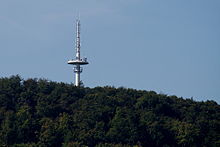
Companies
The Alfelder paper mill is one of the largest employers in the region , alongside the Fagus factory ( Fagus-GreCon and Weinig Grecon) and the Ammann Group (took over the Alfelder Eisenwerke in 1984 ).
The Spies family's paper mill, the origin of the paper mill, was built in 1706. In 1992 the Hannoversche Papierfabriken Alfeld-Gronau AG was integrated into the globally active Sappi Group (South African Pulp and Paper Industries) and renamed Sappi Alfeld in 1998 . One of the company's three production facilities in Germany is located in Alfeld. With around 1000 employees, you produce graphic papers, special papers and cellulose. The Sappi chimney with its 150 m, next to the two 50 m high towers of St. Nicolai and the 22.12 m high Himmelberg tower (at 307.5 m above sea level), is one of the highest landmarks in the city. For the 300th anniversary of the Alfeld paper production, a sculpture by the Goslar artist Monika Jain was unveiled on June 2, 2006. It stands on the roundabout in front of the main entrance to the Sappi site and represents a pan mill , a grinder of a mill. From September 8th to 10th, 2006, the plant opened its doors to the general public for the first time as part of an open house weekend .
The Künkel Wagner Germany GmbH introduces world's 400 employees and 60 million. Forth Euro turnover (2012) foundry and molding machines.
media
- Alfelder Zeitung , daily newspaper
- Sieben , a monthly, free magazine
traffic
Alfeld lies on the Leine and is connected to Hanover via the northern section of the Hanover Southern Railway . This was built from 1847, because Hanover was to be connected to Kassel . A decision was made on the cheapest route, which led through the Leinetal and through Alfeld. The preliminary end point was Göttingen . On April 30, 1853 it was used by the first train. After that, many companies settled in Alfeld, which turned into an industrial city. A commercial area was created in the area of the train station.
About 140 years later (1991) the high-speed line from Hanover to Würzburg replaced the old connection. Nevertheless, the old north-south route is one of the most important and busiest railway lines in Germany. Alfeld got an IC stop and since December 2005 has also been served by the metronom , which replaces the regional trains of the DB Regio . On September 25, 2005, the metronom locomotive ME 146-13 was baptized with the name Alfeld (Leine) (similar to what is shown under "Train naming" ). The modernization of the Alfeld station - built in 1978, followed by the demolition of the old station building - cost a total of 2.72 million euros (financed by the state, federal government, DB and city) and was completed in November 2006 after around ten months.
Since the timetable change in December 2009, the number of intercity trains that serve Alfeld has been greatly reduced. Most IC trains now run on the Hanover – Würzburg high-speed line instead of the Hannöversche Südbahn. Only three intercity connections remained in the Leinetal and stop in Alfeld, Northeim and Kreiensen. In December 2018 these were switched to ICE trains on line 26 .
Local public transport in and around Alfeld is operated by Regionalverkehr Hildesheim (RVHI) with two city bus routes and several regional routes . In addition, a local bus company also has licenses for two regional bus routes from Alfeld to the surrounding towns.
The federal highway B 3 leads directly through the Alfeld district of Limmer and the commercial areas there. The north bypass , completed in 1986, and Göttinger Strasse connect the city with the main road.
Personalities
sons and daughters of the town
- Augustin von Alveldt (around 1480 – around 1535), Franciscan and controversial theologian
- Heinrich Arnold Stockfleth (1643–1708), theologian and poet
- Johann Christoph Harenberg (1696–1774), Protestant theologian and historian, born in the district of Langenholzen
- Heinrich Adolf Schrader (1767–1836), doctor and botanist in Göttingen
- Johann Ernst Arminius von Rauschenplatt (1807–1868), revolutionary and freedom fighter
- Hans Koch (1898–1989), teacher and grammar school director
- Walterkap (1905–1944), National Socialist who, as an emigrant in the USA in the 1930s, carried out propaganda and espionage for the purposes of the NSDAP
- Albrecht Graf von Schlitz called von Görtz and von Wrisberg (1914–2006), designer, born on the Brunkensen manor
- Zbigniew Żedzicki (* 1945), Polish wrestler
- Kurt Eder (* 1946), Austrian politician (SPÖ), authorized signatory
- Siggi Schwientek (* 1952), actor
- Uwe Schmidt (* 1954), politician (SPD) and since July 2009 district administrator of the Kassel district, born in the Brunkensen district
- Ingo Herzke (* 1966), literary translator
- Olaf Levonen (* 1966), politician (SPD) and since September 2016 District Administrator of the Hildesheim district
- Matthias Bode (* 1967), physicist
- Dieter Riefling (* 1968), a nationwide known neo-Nazi
- Bernd Lynack (* 1969), politician (SPD) and member of the state parliament in Lower Saxony
- Marc van Linden (* 1976), House - / Progressive House - DJ and music producer
People connected to the city
- Heinrich Ernst Owen (1685–1758), Lutheran theologian, General Superintendent of the General Diocese of Alfeld
- Wilhelm Barner (1893–1973), teacher and local history researcher, 1958 honorary citizen of the city of Alfeld, director of the local history museum
- Hans-Jürgen Krahl (1943–1970), 1961 founding member of the Junge Union in Alfeld, activist of the 1968 movement
Alfeld in literature
A fairy tale that the literary scholar Karl Goedeke recorded in the vicinity of Alfeld, namely in Delligsen, in 1838 and that was also included in the Grimm brothers' children's and household tales from the 4th edition in 1840 is Das Waldhaus (KHM 169).
A popular tale that takes place in Alfeld is the Räuber-Lippold saga . It can be found, after the Lippoldshöhle was mentioned in the middle of the 17th century, first trained again in the 1840s and was part of the collection of Lower Saxon sagas and fairy tales. Collected from the mouths of the people by Georg Schambach and Wilhelm Müller , Göttingen, printed in 1855. In it u. a. The origin of the blue stone , which adorns the Alfeld coat of arms and is still in front of the town hall today, explains: A young girl from Alfeld, the daughter of the Alfeld mayor according to later versions of the legend, was kidnapped by the robber baron Lippold into his cave near Brunkensen. One day she wanted to go to the market in Alfeld; According to later versions of the legend, Lippold was sick and she was supposed to get medicine from Alfeld. Since she was not allowed to tell anyone anything, she complained to the stone of her suffering. Her tears turned the stone blue. Bystanders heard them, and the next day the Alfeld people hanged the robber in his cave.
The Brothers Grimm planned to publish the distinctive Lippold saga in the third volume of their collection of sagas that was no longer published during their lifetime. The Brothers Grimm have no "spatial reference" to the Alfeld region. That they recorded the fairy tale Snow White in Alfeld is a more recent legend. The Seven Mountains near Alfeld are not the mountains of fairy tales, especially since the Seven Mountains were still called The Seven Brothers in the 19th century , as Heinrich Sohnrey still knows.
Alfeld appeared in the Sachsenchronik ( Cronecken der Sassen ) by Conrad Bothe as early as 1492. There the Alfeld coat of arms was depicted for the first time. In the Topographia Germaniae by Martin Zeiller and Matthäus Merian from 1654, in contrast to many, even smaller neighboring towns, there is no illustration of Alfeld, since the Alfeld authorities at that time replied to Merian's request that they saw no point in paying a printing allowance. However, the Alfeld district of Brunkensen and the Lippoldshöhle are mentioned there. Heinrich Heine mentioned The Salon in his work . Second part under the heading On the history of religion and philosophy in Germany, the Hödekensage . Heinrich Sohnrey had his novel Der Bruderhof from 1895 set near Alfeld and processed Alfeld legend motifs, such as the Kirkstein on the Nattenberg and the Nachtraben.
In Tom Clancy's novel Im Sturm , the city of Alfeld is a strategically important location for both NATO and the Soviet armed forces. Both fight for oil wells in the Middle East in 1986 . The Red Army is supposed to put down an alleged German threat. Alexejew, the deputy general of the Russians, succeeds in breaking through at Alfeld.
literature
- Horst Berndt (ed.): The Latin school in Alfeld . Imhof, Petersberg 2010, ISBN 978-3-86568-621-3 .
- Forum Alfeld Aktiv e. V. (Ed.): Alfeld University of Education (Leine) 1946–1970 - facts and memories written down by students born in 1946–1965 . Alfeld 2009, OCLC 554820179 .
- Paul Graff: History of the Alfeld district . A. Lax, Hildesheim 1928, DNB 579468534 .
- Wilhelm Heinze: History of the city of Alfeld . Alfeld 1894, DNB 361485565 .
- Gerhard Kraus: Buildings and symbols in the old Alfeld . PDV-Sachbuchverlag, Hanover 1986, ISBN 3-925490-03-5 .
- Gerhard Kraus: Allfeldt - The city of Alfeld in the Middle Ages . Alfeld 2006.
- Bernd Lauenroth, Wolfgang Schäfer (Ed.): The other Alfeld - industrial culture in the Leinetal . Mitzkat, Holzminden 2008, ISBN 978-3-940751-03-4 .
- Martha Scale: History of the city of Alfeld (Leine) in a more recent perspective . Alfeld 1973, DNB 770582125 .
- City of Alfeld (Hrsg.): Alfeld in the industrial age - contributions to the history of a small town in Lower Saxony . Alfeld 2008, ISBN 978-3-00-024212-0 .
- City of Alfeld (Hrsg.): Museum of the city of Alfeld - collection of exotic animal preparations . Alfeld 1996.
- Godehard Wolski (Ed.): Alfelds wilde Zeiten - 125 years of Alfeld city stories . Schaper, Alfeld 1996, ISBN 3-7944-0182-4 .
- Matthias Quintel (Hrsg.), Thorsten Schütz: alt-alfeld - The book on the website - Historical views & reports on the modern history of the city. Alfeld 2011.
- Matthias Quintel (Ed.), Thorsten Schütz: alt-alfeld - The SECOND book on the website - Historical views & reports on the city's recent history. Alfeld 2016.
- Matthias Quintel (ed.), Thorsten Schütz: "alt-alfeld - yesterday & today" - historical comparison of images. Alfeld 2013.
Web links
- Website of the city of Alfeld (Leine)
- History of the city of Alfeld (Leine) with historical photos, film and sound documents
Individual evidence
- ↑ State Office for Statistics Lower Saxony, LSN-Online regional database, Table 12411: Update of the population, as of December 31, 2019 ( help ).
- ↑ 1214 "villicus episcopi de Alvelde", 1221 "villa Alvelde", 1250 "plebanus in Alvelde", 1258 "sacerdos veteris villae apud Alvelde", 1297 "consules et universitas Civium in Alvelde". (Dörries, Hans: Origin and Formation of the Lower Saxony City, Stuttgart 1929, p. 136.) In the introduction to the Alfeld town law of 1456, which was improved by Bishop Bernhard, it says u. a .: "Ock schall de radt rekenschup don vor twolf mannen uth guilds and my community."
- ↑ Ibid.
- ^ Jürgen Udolph (research): The "place name researcher". (No longer available online.) In: Internet site NDR 1 Lower Saxony . Archived from the original on December 7, 2015 ; accessed on October 10, 2018 .
- ^ Federal Statistical Office (ed.): Historical municipality directory for the Federal Republic of Germany. Name, border and key number changes in municipalities, counties and administrative districts from May 27, 1970 to December 31, 1982 . W. Kohlhammer, Stuttgart / Mainz 1983, ISBN 3-17-003263-1 , p. 205 .
- ^ Lower Saxony Municipal Constitutional Law (NKomVG); Section 46 - Number of Deputies. In: Internet site for the Lower Saxony Regulation Information System (NI-VORIS). December 17, 2010, accessed July 8, 2019 .
- ↑ a b c Council of the City of Alfeld (Leine). In: Website of the city of Alfeld. Retrieved August 23, 2018.
- ^ Election results 2016. In: Internet site of the city of Alfeld. Retrieved September 4, 2017.
- ^ Election results 2011. In: Internet site of the city of Alfeld. Retrieved September 4, 2017.
- ↑ Mayoral election 2016. In: Internet site of the city of Alfeld. Retrieved September 4, 2017.
- ^ A b Wilhelm Barner : Coat of arms and seal of the Alfeld district . Rebinding. Lax GmbH & Co. KG, Hildesheim 1998 ( digitized version of the text part of the first edition from 1940 [PDF; 10.0 MB ; accessed on June 9, 2019]).
- ↑ City museum / former Latin school and animal museum. In: Website of the city of Alfeld. Retrieved February 18, 2019.
- ↑ Document from 1501. In: Internet site Ratsbadstube Alfeld. Retrieved May 15, 2013.
- ↑ http://www.heute.de/ZDFheute/inhalt/8/0,3672,8247816,00.html (link not available)
- ↑ Eckart Roloff , Karin Henke-Wendt: Everything about the Ronchopathy that millions suffer from. (Das Schnarchmuseum Alfeld) In: Visit your doctor or pharmacist. A tour through Germany's museums for medicine and pharmacy. Volume 1, Northern Germany. Verlag S. Hirzel, Stuttgart 2015, pp. 79-80, ISBN 978-3-7776-2510-2 .
- ^ Return on Sunday. July 14, 2013, p. 10.
- ↑ 26th Hirschberg home meeting in Alfeld. In: Website of the city of Alfeld. Retrieved September 3, 2010.
- ^ Waltraud Friedemann: Support for the work of the Patschenschft Hirschberg Board of Trustees. In: www.spd-kreistagsfraktion-hildesheim.de. May 23, 2012, accessed May 15, 2013.
- ^ Website Künkel-Wagner Germany GmbH
- ^ Christian Haegele (report), Michael Reinboth (comment): Press release from the Ministry of Economic Affairs. In: www.suedharzlinie.de. Retrieved December 19, 2009.
- ↑ Schambach / Müller, Nds. Legends and fairy tales, Göttingen 1855, p. 47 ff.
- ↑ B. Kindermann-Bieri (ed.), Brothers Grimm, Deutsche Sagen, Volume 3, Darmstadt 1993, p. 100
- ↑ Sohnrey: The Bruderhof. Berlin 1926, p. 5.
- ↑ Cronecken der Sassen / Conrad Bote. Mencz: Peter Schöffer, 6.III.1492, Pag. 121.
- ↑ Zeiller: Topographia and actual description of the foremost places, castles and other places and places in the Hertzogtümern Braunschweig and Lüneburg. Frankfurt 1654, p. 60 ff.
- ↑ Sohnrey, Der Bruderhof, Berlin 1926, p. 86 ff.





